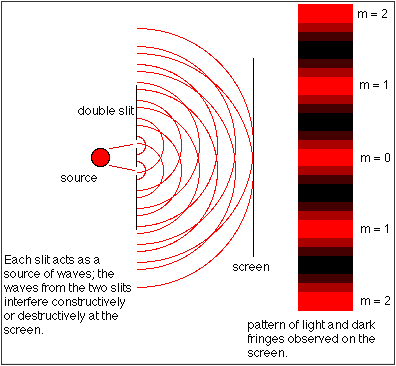
You are here: Home >> History of Light >> The two natures >> A new thought

In 1803 the English scientist Thomas Young studied interference of light waves by letting light pass through a screen with two slits.
In this configuration, the light from each slit spreads out according to Huygens' Principle and eventually overlaps with light from the other slit. If a screen is set up in the region where the two waves overlap, a point on the screen will be light or dark depending on whether the two waves interfere constructively or destructively.
If the difference between the distance from one slit to a point on the screen and the other slit to the same point on the screen is an exact number of wavelengths, then light waves arriving at that point will be in step and constructively interfere, making the point bright.  If the difference is an exact odd number of half wavelengths, then light waves will arrive out of step, with one wave's trough arriving at the same time as another wave's peak. The waves will destructively interfere, making the point dark.
If the difference is an exact odd number of half wavelengths, then light waves will arrive out of step, with one wave's trough arriving at the same time as another wave's peak. The waves will destructively interfere, making the point dark.
The resulting pattern is a series of parallel bright and dark lines on the screen.
Young's experiment was not easily accepted. It had been less than 100 years since Newton's death and his image was still present.
Furthermore, Newton was the only scientist who had been announced Knight at 1705, 18 years before his death, and both were English. As a result, it was much better the fact that a French scientist, L. Foucault was the one that accepted this "non patriotic" theory. Foucault proved independently that the speed of light in air is greater than it is in water.
It is funny that before Foucault all the scientific community denied Young, but after him the wave nature of light was hackneyed.
Related links (external pages)